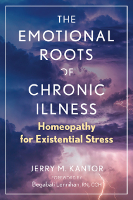The U.S. Food and Drug Administration (FDA) designates homeopathic medicines as drugs. Although commonly used to resolve acute conditions, homeopathy’s most transformative expression is in its constitutional (or classical) form, typically applied for the sake of reversing the course of chronic illness. Constitutional homeopathy is homeopathy at its best, as well as the first and most powerful version of a nano-medical system.
Homeopathy’s central dictum, the law of similars (use like to cure like), may be restated: In the appropriate situation, illness or disease symptoms are effectively addressed by a substance whose otherwise toxic effect is to produce equivalent or similar symptoms.
HOMEOPATHY AS ANTIVENOM
A version of the law of similars underlies production of drugs known as antivenoms. Homeopathic medicines may therefore be compared to antivenom used to counteract snakebite. Here a nonlethal amount of the collected venom of a poisonous snake is injected into a large mammal, such as a horse. By way of combatting the venom’s toxicity, the horse’s immune system produces antibodies. These are harvested from the horse’s blood serum in order to produce the antivenom administered to a human bitten by the same snake.
While antivenom for snakebites works only when made from the specific venom, homeopathic medicines have a much broader sphere of action. A homeopathic medicine can be used for any condition similar to one that the full-strength starting substance could create.
BYPASSING THE MIDDLEMAN
Bypassing the middleman. . . Or in this case the middle mammal. Homeopathic medicines can be prepared from a dilution of the same snake venom and directly administered to an individual suffering from symptoms closely akin to those caused by the snakebite. So long as homeopathic medicines are prescribed in accordance with the law of similars, the FDA officially views them as pharmaceuticals, imbuing a status that nutritional supplements and herbs lack.
Commonly known as remedies, homeopathics can address psychological symptoms unrelated to the original starting substance. For example, Natrum muriaticum (or Nat. mur. for short, made from sodium chloride or common table salt) is well known in homeopathy for its ability to release people from silent grief (as in, my husband died and I never shed a tear.). How can table salt help with long-held, unexpressed grief?
When table salt—or any substance—is put through the special homeopathic manufacturing process known as “dynamization” or “potentiation,” it develops the ability to heal on mental, emotional, energetic, behavioral, and even spiritual levels. It also foments healing of physical conditions untreatable with table salt. In the case of Natrum muriaticum these include conditions of dryness (dry mouth, dry skin) or water retention.
Homeopaths learn which symptoms match each remedy by means of a research methodology called a “proving.” A group of healthy people take the remedy in a low potency (more material, less energy) and monitor their responses. Their observations are collected, organized, and ranked in importance so as to become a part of the materia medica of the remedy.
As homeopaths use it and share their success stories, their clinical experience serves to expand the original materia medica profile. For example, although thyroid conditions did not appear in Natrum muriaticum’s proving, over time the medicine was nevertheless found to be effective for thyroid conditions.
SIMILARITY VS DUPLICATION
The use of the word “like” in the law of similars alludes to something being akin to and not identical. This is because homeopathy requires similarity of action, not duplication. When the principle relies on identity rather than similarity, such as in treatment of an actual snakebite with the same snake’s toxin, such treatment is designated tautopathy, not homeopathy.
An example of tautopathy is when the medicine Rhus tox works quickly to quell the itching of a skin rash resulting from exposure to the same poison ivy plant that was diluted to make the Rhus tox remedy.
HOMEOPATHY AS NANO-MEDICINE
Information from the medicinal substance is stored in the water by creating formations like ice crystals or snowflakes, the shape of each one determined by the starting substance. The resulting formations store medicinal information, somewhat like the nanotechnology computer chips that store information in tiny compounds only one molecule wide.
The work of Dr. Bell suggests that nano-medicine is epitomized by homeopathy. In her paper “Adaptive Network Nanomedicine: An Integrated Model for Homeopathic Medicine,” alternative medicine researcher Iris Bell equates the constituents of homeopathic medicines with miniscule entities known as nanoparticles and nanobubbles. These are shown in low doses to impact biological cells, creating homeostasis or promoting hormetic effects.
REMEDY PRODUCTION
The dilution process renders the medicines safe. They are diluted to such an extent that according to the laws of conventional chemistry, there should be no molecules of the starting substance in the dilution.
Cutting-edge research in the realm of ultra-dilution physics has demonstrated that in fact there are molecules even in highly diluted homeopathic remedies. Continuing developments within science—for example, the work of the 2008 Nobel Prize–winning virologist Luc Montagnier—indicate that homeopathic effects reflect the ability of water molecules to retain memory of a diluted substance’s imprint.
VACCINES, RITALIN, AND THE LAW OF SIMILARS
The law of similars is not the exclusive domain of homeopaths. Vaccines capitalize on the idea of using one pathogen to provoke host immunity to a similar pathogen. Inoculation differs from homeopathy in that vaccines contain a greater amount of the original pathogenic substance. Also, as opposed to homeopathy’s customized method, vaccines use a one-size-fits-all approach.
Pediatricians invoke an untoward version of the law of similars when treating hyperactive children with the amphetamine-like drug Ritalin, the brand name for methylphenidate. At least in the short run, Ritalin’s stimulant action produces the paradoxical effect of moderating hyperactive behavior. This is due to the drug’s being an agonist—a biochemical enabling agent.
Ritalin’s binding to opiate receptors allows neurotransmitters such as dopamine and norepineph-rine to avoid reuptake and linger in the synapse (neuron juncture). Desirable though temporary effects such as euphoria, better hearing, or strengthened focus result. Before long, the drug’s antagonistic and less desirable effects, including dazedness, aggression, a sense of being shut off from reality, and addictiveness, start to manifest.
The principle can be found at play outside of medicine. The expression “hair of the dog that bit you” refers to what drinkers do to ameliorate a morning-after hangover—imbibe a dose of the alcoholic beverage that intoxicated them the previous night.
The Law of Similars within Psychology
The law of similars can also be triggered in a non-physiological context.
Stockholm Syndrome
An act of piracy committed has lent the name of the ship on which it was perpetrated to a psychological phenomenon known as identification with the oppressor. Its mechanism has broad implications for homeopathic remedy analysis.
Stockholm syndrome is named after a hostage situation in Stockholm in 1973, in which four bank employees bonded with their captors, sided with them against police, and defended them later in court. Psychologists believe that this tendency to identify with someone who is actually abusive, threatening, or dangerous is a coping mechanism in a situation when the victim cannot escape. Stockholm syndrome can also be acquired in consequence of having experienced long-term abuse. Constitutional remedy states thus mirror trauma’s effects.
You Can Be Hurt Only at Your Strength
Clinical experience has prompted my adoption of an adage related to Stockholm Syndrome’s identification with the oppressor phenomenon: “You can be hurt only at your strength.” Thus, if someone has been attacked by criticism at a point of weakness, it matters little as the person is uninvested—already weak on that point. The attack fails to alter the target’s perspective.
For example, you can charge me as being an atrocious needlepoint embroiderer. Go ahead, sue me! I don’t care, never having aspired to any such skill! On the other hand, when attacked and overcome at a point of strength, for example in regard to possessing self-confidence, or certitude that specific idealistic values are universal, or skill as a parent, the impact of that attack on my personal strength is more than perspective altering, it is devastating.
When one’s ingrained mindset—values antithetical to those of a perpetrator—are transformed, the result is not merely agreeable concession; the crushing and supplanting of the victim’s values engenders fervent adoption of a kidnapper’s or abuser’s ideology.
This type of response is also encountered in therapeutic treatment where psychic trauma brought to light reflects the patient’s having at some time been crushed at a point of strength. An example is the psyche of someone whose mind, having been subjected to longstanding belittlement by parents or caregivers, buys into their insistence that she is inferior, worthless, stupid, or incompetent. As in Stockholm Syndrome, such an individual has adopted as her own the perspective of her oppressors. The situation often calls for the constitutional remedy Thuja to be prescribed.
Prescribe the Symptom
Using like to cure like is exploited within psychology by therapists such as Victor Frankl, Milton Erikson, and their disciples: A “reverse” psychology is employed wherein the same symptom bedeviling a patient is then prescribed (recommended). Utilizing a commonsense principle, the patient is encouraged to exaggerate and wallow in his undesired behavior until its emotional impetus is exhausted and the symptom’s raison d’etre is no more.
CONSTITUTIONAL DIAGNOSIS
A patient visiting a homeopath with a specific concern, migraine pain for example, may be startled to find the homeopath inspecting him with a wide-angle lens that considers not only his headaches but the totality of his symptoms, behaviors, and even beliefs. This is because additional symptoms—the context surrounding the patient’s headaches—provide fertile ground within which the ailment can flourish.
Lurking within this fertile ground is a covert issue, an existential question underlying the patient’s migraine headache susceptibility. Thus, to return to an earlier example, underlying the Natrum muriaticum remedy-state is an existential issue—a question containing powerful emotional charge: Though the depth of my grief is apparent, I must keep consolation at arm’s length. How else to honor the depth of my great loss? Here we locate the conflict lying at the heart of the patient’s migraine headaches.
Finding a Proper Constitutional Remedy
If the effectiveness of a homeopathic medicine hinges on its being accurately prescribed, what then determines its accuracy? The first requirement is that an ideal match between the symptoms we wish to ameliorate and the substance associated with those very same symptoms is found. Invaluable to this matching game is grasping a remedy’s essence:
-
The practitioner should be able to articulate the remedy’s key idea, meaning the specific existential problem with which the patient is grappling, and that via conversion, somaticizes as the patient’s symptoms.
-
There are characteristic polarities (strengths and weaknesses) within the remedy state (radical disjunct).
-
The terrain of action indicates chief mental or emotional features as well as the principal body system or systems affected.
Potentiation
The second requirement is that the substance will have been potentized. A key concept in the preparation of constitutional remedies, potentized means increased with regard to energy (at the same time that it is lessened with regard to amount). Vigorous shaking (succussion) while systematically diluting the actual substance has been found to heighten the remedy’s effect.
In its energized, as opposed to materially dense form, the remedy registers within consciousness at a high level of function. The resulting energized micro-dosage of our original substance is a homeopathic remedy.
A constitutional homeopath specializes in finding a remedy maximally parallel to the patient. To succeed in her quest the practitioner must scrutinize a terrain encompassing the patient’s physical symptoms, cognition (mental features), and affect (characteristic emotional behavior). The homeopath’s holy grail is then the similimum, a remedy ideally matching the totality of symptoms exhibited by the patient.
Copyright 2023. All Rights Reserved.
Adapted with permission of the publisher,
Healing Arts Press, an imprint of Inner Traditions Intl.
Article Source:
BOOK:The Emotional Roots of Chronic Illness
The Emotional Roots of Chronic Illness: Homeopathy for Existential Stress
by Jerry M. Kantor
 Jerry M. Kantor presents diagnostic insight, specific homeopathic remedies, and successful case studies about the profound connections between emotions and their physical manifestations in illness. He further correlates the five classical miasms and their core existential quandaries with the Five Elements and Phase Theory of Traditional Chinese Medicine (TCM). He likens inborn foundational emotions to tools, each one designed to solve a stress-related problem. Self-sabotaging imbalances occur when an emotional tool is excessively used.
Jerry M. Kantor presents diagnostic insight, specific homeopathic remedies, and successful case studies about the profound connections between emotions and their physical manifestations in illness. He further correlates the five classical miasms and their core existential quandaries with the Five Elements and Phase Theory of Traditional Chinese Medicine (TCM). He likens inborn foundational emotions to tools, each one designed to solve a stress-related problem. Self-sabotaging imbalances occur when an emotional tool is excessively used.
Revealing that the subconscious mind is amenable to change, Jerry shows how to accurately select remedies to defuse the energetic charge of unresolved existential stress and thus quell the root causes of chronic illness.
For more info and/or to order this book, click here. Also available as a Kindle edition.
About the Author
 Jerry M. Kantor, L.Ac., CCH, MMHS, is a faculty member of the Ontario College of Homeopathic Medicine and owner of Vital Force Health Care LLC, a Boston-area homeopathy and acupuncture practice. The first acupuncturist to receive an academic appointment at Harvard Medical School’s Department of Anaesthesiology, Jerry Kantor is the author of Interpreting Chronic Illness, The Toxic Relationship Cure, and Autism Reversal Toolbox.
Jerry M. Kantor, L.Ac., CCH, MMHS, is a faculty member of the Ontario College of Homeopathic Medicine and owner of Vital Force Health Care LLC, a Boston-area homeopathy and acupuncture practice. The first acupuncturist to receive an academic appointment at Harvard Medical School’s Department of Anaesthesiology, Jerry Kantor is the author of Interpreting Chronic Illness, The Toxic Relationship Cure, and Autism Reversal Toolbox.
Visit his website at VitalForceHealthCare.com/


























